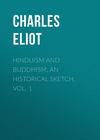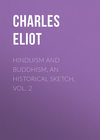Читать книгу: «Hinduism and Buddhism, An Historical Sketch, Vol. 1», страница 35
4
What then is the position of the Buddha himself in this universe of many worlds and multitudinous deities? European writers sometimes fail to understand how the popular thought of India combines the human and superhuman: they divorce the two aspects and unduly emphasize one or the other. If they are impressed by the historical character of Gotama, they conclude that all legends with a supernatural tinge must be late and adventitious. If, on the other hand, they feel that the extent and importance of the legendary element entitles it to consideration, they minimize the historical kernel. But in India, reality and fancy, prosaic fact and extravagant imagination are found not as successive stages in the development of religious ideas, but simultaneously and side by side. Keshub Chunder Sen was a Babu of liberal views who probably looked as prosaic a product of the nineteenth century as any radical politician. Yet his followers were said to regard him as a God, and whether this is a correct statement or not, it is certain that he was credited with superhuman power and received a homage which seemed even to Indians excessive738. It is in the light of such incidents and such temperaments that we should read the story of the Buddha. Could we be transported to India in the days of his preaching, we should probably see a figure very like the portrait given in the more sober parts of the Pitakas, a teacher of great intelligence and personal charm, yet distinctly human. But had we talked about him in the villages which lay along his route, or even in the circle of his disciples, I think we should have heard tales of how Devas visited him and how he was wont to vanish and betake himself to some heaven. The Hindu attributes such feats to a religious leader, as naturally as Europeans would ascribe to him a magnetic personality and a flashing eye.
The Pitakas emphasize the omniscience and sinlessness of the Buddha but contain no trace of the idea that he is God in the Christian or Mahommedan sense. They are consistently non-theistic and it is only later that Buddhas and Bodhisattvas become transformed into beings about whom theistic language can be used. But in those parts of the Pitakas which may be reasonably supposed to contain the ideas of the first century after the Buddha's death, he is constantly represented as instructing Devas and receiving their homage739. In the Khuddaka-pâṭha the spirits are invited to come and do him reverence. He is described as the Chief of the World with all its gods740, and is made to deny that he is a man. If a Buddha cannot be called a Deva rather than a man, it is only because he is higher than both. It is this train of thought which leads later Buddhists741 to call him Devâtideva, or the Deva who is above all other Devas, and thus make him ultimately a being comparable with Siva or Vishnu.
The idea that great teachers of mankind appear in a regular series and at stated intervals is certainly older than Gotama, but it is hard to say how far it was systematized before his time. The greatness of the position which he won and the importance of the institutions which he founded naturally caused his disciples to formulate the vague traditions about his predecessors. They were called indifferently Buddha, Jina, Arhat, etc., and it was only after the constitution of the Buddhist church that these titles received fixed meanings.
Closely connected with the idea of the Buddha or Jina is that of the Mahâpurusha or great man. It was supposed that there are born from time to time supermen distinguished by physical marks who become either universal monarchs (cakra-vartin) or teachers of the truth. Such a prediction is said to have been made respecting the infant Gotama and all previous Buddhas. The marks are duly catalogued, as thirty-two greater and eighty742 smaller signs. Many of them are very curious. The hair is glossy black: the tongue is so long that it can lick the ears: the arms reach to the knees in an ordinary upright position: the skin has a golden tinge: there is a protuberance on the skull and a smaller one, like a ball, between the eyebrows. The long arms may be compared with the Persian title rendered in Latin by Longimanus743 and it is conceivable that the protuberances on the head may have been personal peculiarities of Gotama. For though the thirty-two marks are mentioned in the Pitakas as well-known signs establishing his claims to eminence, no description of them has been found in any pre-Buddhist work744, and they may have been modified to suit his personal appearance. At any rate it is clear that the early generations of Buddhists considered that the Master conformed to the type of the Mahâpurusha and attached importance to the fact745. The Pitakas repeatedly allude to the knowledge of these marks as forming a part of Brahmanic training and in the account of the previous Buddha Vipassî they are duly enumerated. These ideas about a Great Man and his characteristics were probably current among the people at the time of the Buddha's birth. They do not harmonize completely with later definitions of a Buddha's nature, but they show how Gotama's contemporaries may have regarded his career.
In the older books of the Pitakas six Buddhas are mentioned as preceding Gotama746, namely Vipassî, Sikhî, Vessabhû, Kakusandha, Konâgamana and Kassapa. The last three at least may have some historical character. The Chinese pilgrim Fa Hsien, who visited India from 405 to 411 A.D., saw their reputed birthplaces and says that there still existed followers of Devadatta (apparently in Kosala) who recognized these three Buddhas but not Gotama. Asoka erected a monument in honour of Konâgamana in Nepal with a dedicatory inscription which has been preserved. In the Majjhima-Nikâya747 we find a story about Kakusandha and his disciples and Gotama once gave748 an extended account of Vipassî, whose teaching and career are represented as almost identical with his own. Different explanations have been given of this common element. There is clearly a wish to emphasize the continuity of the Dhamma and the similarity of its exponents in all ages. But are we to believe that the stories, true or romantic, originally told of Gotama were transferred to his mythical forerunners or that before his birth there was a Buddha legend to which the account of his career was accommodated? Probably both processes went on simultaneously. The notices of the Jain saints show that there must have been such legends and traditions independent of Gotama. To them we may refer things like the miracles attending birth. But the general outline of the Buddha's career, the departure from home, struggle for enlightenment and hesitation before preaching, seem to be a reminiscence of Gotama's actual life rather than an earlier legend.
There is an interesting discourse describing the wonders that attend the birth of a Buddha749, such as that he passes from the Tusita heaven to his mother's womb; that she must die seven days after his birth: that she stands when he is born: and so on. We may imagine that the death of the mother is due to the historical fact that Gotama's mother did so die, while the other circumstances are embellishments of the old Buddha and Mahâpurusha legend. But the construction of this sutta is curious. The monks in the Jetavana are talking of the wondrous powers possessed by Buddhas. Gotama enters and asks what is the subject of their discourse. They tell him and he bids Ânanda describe more fully the wondrous attributes of a Buddha. Ânanda gives a long list of marvels and at the end Gotama observes, "Take note of this too as one of the wondrous attributes of a Buddha, that he has his feelings, perceptions and thoughts under complete control750."
No passage has yet been adduced from the suttas mentioning more than seven Buddhas but later books, such as the Buddha-vaṃsa and the introduction to the Jâtaka, describe twenty-five751. There are twenty-four Jain Tîrthankaras and according to some accounts twenty-four incarnations of Vishnu. Probably all these lists are based on some calculation as to the proper allowance of saints for an aeon. The biographies of these Buddhas are brief and monotonous. For each sage they record the number of his followers, the name of his city, parents, and chief disciples, the tree under which he attained enlightenment, his height and his age, both in extravagant figures. They also record how each met Gotama in one of his previous births and prophesied his future glory. The object of these biographies is less to give information about previous Buddhas than to trace the career of Gotama as a Bodhisattva. This career began in the time of Dîpankara, the first of the twenty-five Buddhas, incalculable ages ago, when Gotama was a hermit called Sumedha. Seeing that the road over which Dîpankara had to pass was dirty, he threw himself down in the mire in order that the Buddha might tread on him and not soil his feet. At the same time he made a resolution to become a Buddha and received from Dîpankara the assurance that ages afterwards his wish would be fulfilled. This incident, called praṇidhâna or the vow to become a Buddha, is frequently represented in the frescoes found in Central Asia.
The history of this career is given in the introduction to the Jâtaka and in the late Pali work called the Cariyâ-piṭaka, but the suttas make little reference to the topic. They refer incidentally to Gotama's previous births752 but their interest clearly centres in his last existence. They not infrequently use the word Bodhisattva to describe the youthful Gotama or some other Buddha before the attainment of Buddhahood, but in later literature it commonly designates a being now existing who will be a Buddha in the future. In the older phase of Buddhism attention is concentrated on a human figure which fills the stage, but before the canon closes we are conscious of a change which paves the way for the Mahâyâna. Our sympathetic respect is invited not only for Gotama the Buddha, but for the struggling Bodhisattva who, battling towards the goal with incredible endurance and self-sacrifice through lives innumerable, at last became Gotama.
It is only natural that the line of Buddhas should extend after as well as before Gotama. In the Pitakas there are allusions to such a posterior series, as when for instance we hear753 that all Buddhas past and to come have had and will have attendants like Ânanda, but Metteya the Buddha of the future has not yet become an important figure. He is just mentioned in the Dîgha Nikâya and Buddha-Vaṃsa and the Milinda Pañha quotes an utterance of Gotama to the effect that "He will be the leader of thousands as I am of hundreds," but the quotation has not been identified.
The Buddhas enumerated are supreme Buddhas (Sammâ-sam-buddha) but there is another order called Pacceka (Sanskrit Pratyeka) or private Buddhas. Both classes attain by their own exertions to a knowledge of the four truths but the Pacceka Buddhas are not, like the supreme Buddhas, teachers of mankind and omniscient754. Their knowledge is confined to what is necessary for their own salvation and perfection. They are mentioned in the Nikâyas as worthy of all respect755 but are not prominent in either the earlier or later works, which is only natural, seeing that by their very definition they are self-centred and of little importance for mankind. The idea of the private Buddha however is interesting, inasmuch as it implies that even when the four truths are not preached they still exist and can be discovered by anyone who makes the necessary mental and moral effort. It is also noticeable that the superiority of a supreme Buddha lies in his power to teach and help others. A passionless and self-centred sage falls short of the ideal.












